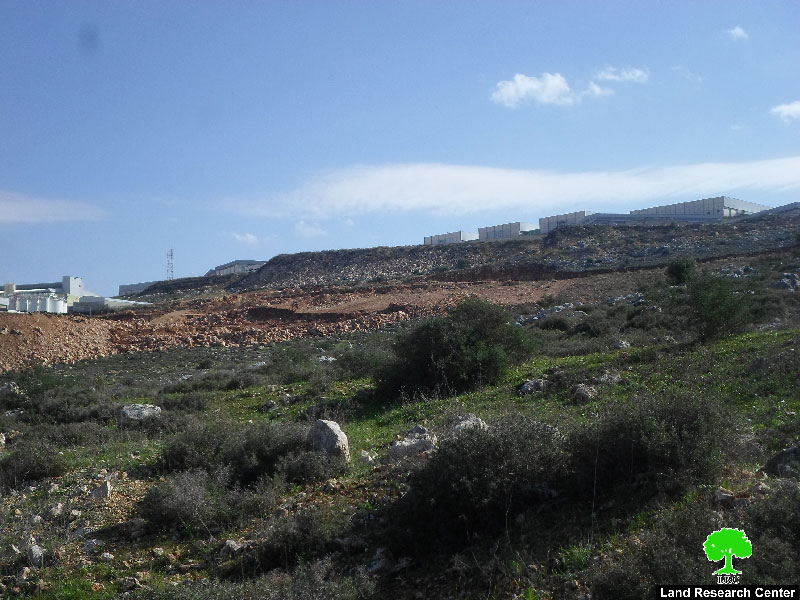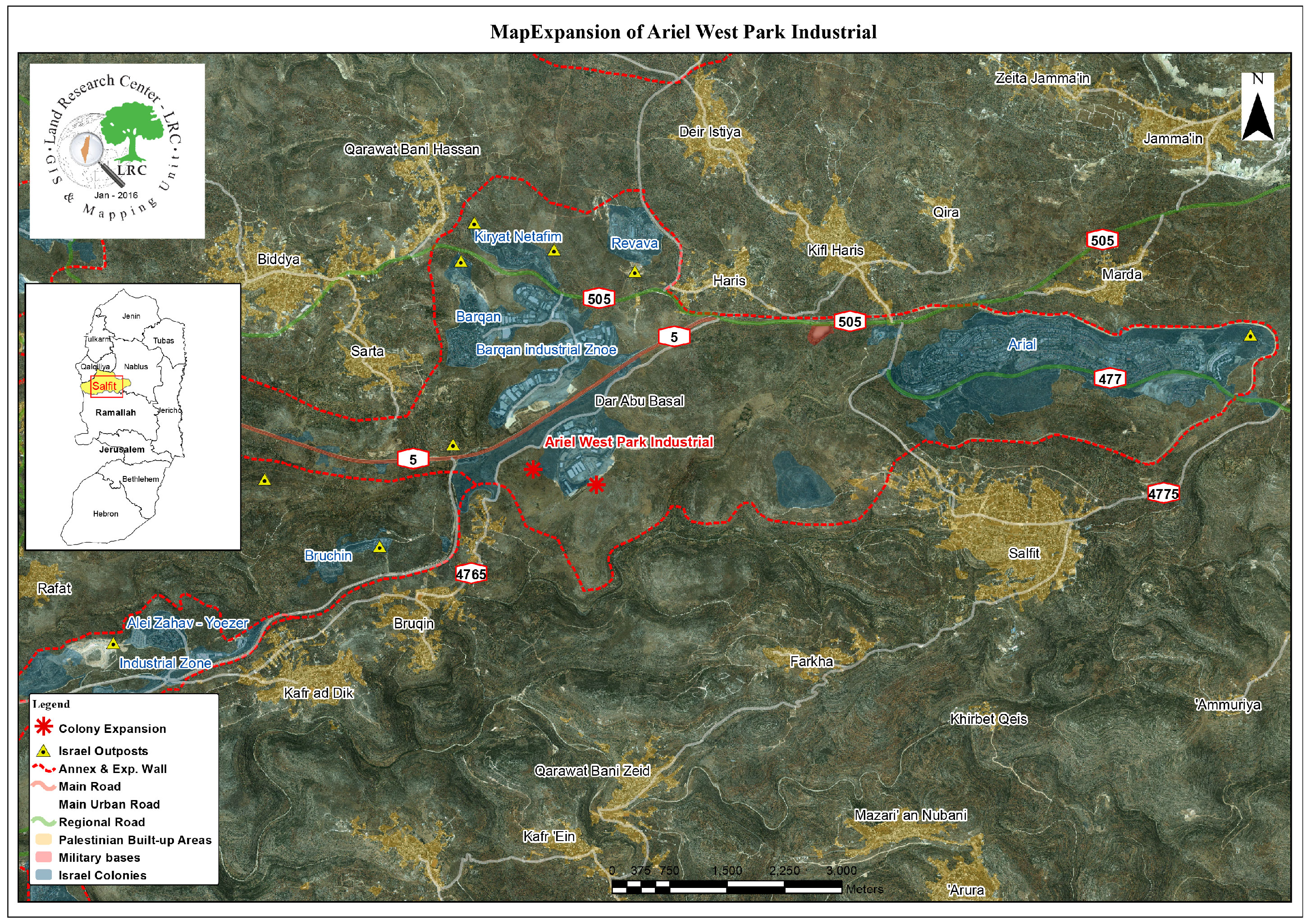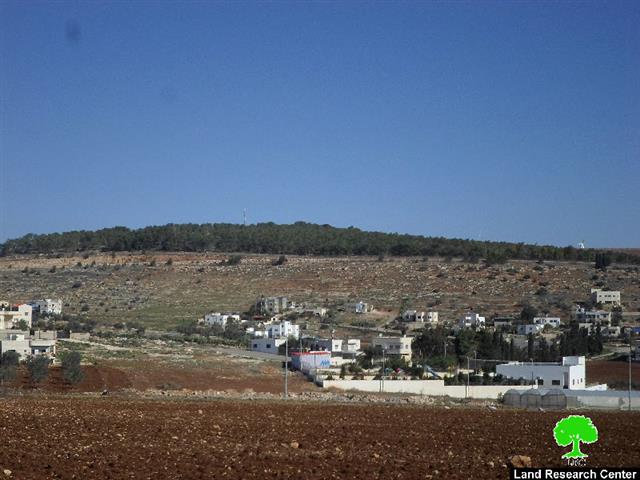Violation: Ariel takes over some Salfit lands
Location: Bruqin village- Salfit governorate
Date: December 01, 2015
Perpetrators: Ariel colony
Details:
In the shadow of the latest uprising of Jerusalem that started late September 2015, the Israeli occupation worked day and night to take over more Palestinian lands, taking the advantage of the wave of unrest that swept Palestine as a whole. Lately, it was reported that Ariel colony was active in ravaging Palestinian agricultural lands in its periphery for the favor of expanding the colony’s built-up area.
According to Land Research Center field follow-up, the ravaging works were focused in the western and southern parts of the Industrial Zone. More than 40 dunums were totally swept until the day of preparing this report. Noteworthy, the swept lands are part of Bruqin village.
The aim behind the ravaging works is to create room and infrastructure to accommodate more Israeli factories, which in their term pollute and damage the environment in the area.
Photos 1+2: Ariel factories with a view of the ravaging works
It should be marked that those factories don’t follow standards of health conditions when disposing solid waste. The occupation took advantage of the factories being located outside the borders of “the State of Israel” so that such factories can get rid of their toxics and waste in Palestinian areas.
Ariel industrial zone:
It should be marked that the Israeli authorities confiscated in 1999 a vast area of lands from the Palestinian villages of Haris, Surtta and Bruqin for the sake of establishing a core for a colonial industrial zone that is to the west from the colony of Ariel.
Ever since, the industrial zone has been witnessing a rapid growth at the level of infrastructure and the number of factories established there. Famous factories in the area produce oils, agricultural plastic and threads. Noteworthy, the Israeli government has given so many privileges for those factories such like tax reduction, logistic services and other promoting services.
Land Research Center sees Israel continuous expansion on colonies in the West Bank and Jerusalem at the expense of Palestinian and lands a flagrant violation of Human Rights and all international laws and conventions, which prohibit disposition of public properties in occupied countries.
UN Resolutions
UN Security Council Resolution 242 of 1967: calls for
- the Withdrawal of Israel armed forces from territories occupied in the recent conflict;
- Termination of all claims or states of belligerency and respect for and acknowledgment of the sovereignty, territorial integrity and political independence of every State in the area and their right to live in peace within secure and recognized boundaries free from threats or acts of force." [4]
UN Security Council Resolution 449 of 1979: the Security Council determined:
- "that the policy and practices of Israel in establishing settlements in the Palestinian and other Arab territories occupied since 1967 have no legal validity and constitute a serious obstruction to achieving a comprehensive, just and lasting peace in the Middle East"
UN Security Council Resolution 452 of 1979: states that
- "the policy of Israel in establishing settlements in the occupied Arab territories has no legal validity and constitutes a violation of the Fourth Geneva Convention relative to the Protection of Civilian Persons in Time of War of 12 August 1949" and "calls upon the Government and people of Israel to cease, on an urgent basis, the establishment, construction and planning of settlements in the Arab territories occupied since 1967, including Jerusalem."
UN Security Council Resolution 465 of 1980:
- It expressed concern at Israeli settlement policy in the Arab territories and recalled resolutions 237 (1967), 252 (1968), 267 (1969), 271(1969) and 298 (1971). It further called upon the State and people of Israel to dismantle such settlements. The resolution calls on all states ‘not to provide Israel with any assistance to be used specifically in connection with settlements in the occupied territories’.
UN Security Council resolutions in regard to Israeli colonies:
UN Security Council resolution 446, article 3 " Calls once more upon Israel, as the occupying Power, to abide scrupulously by the 1949 Fourth Geneva Convention, to rescind its previous measures and to desist from taking any action which would result in changing the legal status and geographical nature and materially affecting the demographic composition of the Arab territories occupied since 1967, including Jerusalem, and, in particular, not to transfer parts of its own civilian population into the occupied Arab territories;"
- Un Security Council resolution 452, article 3"Calls upon the Government and people of Israel to cease, on an urgent basis, the establishment, construction and planning of settlements in the Arab territories occupied since 1967, including Jerusalem;"
- Un Security Council resolution 465, Strongly deplores the continuation and persistence of Israel in pursuing those policies and practices and calls upon the Government and people of Israel to rescind those measures, to dismantle the existing settlements and in particular to cease, on an urgent basis, the establishment, construction and planning of settlements in the Arab territories occupied since 1967, including Jerusalem;
Calls upon all States not to provide Israel with any assistance to be used specifically in connexion with settlements in the occupied territories;
- Un Security Council resolution 242, Affirms that the fulfilment of Charter principles requires the establishment of a just and lasting peace in the Middle East which should include the application of both the following principles:
(i) Withdrawal of Israel armed forces from territories occupied in the recent conflict;
(ii) Termination of all claims or states of belligerency and respect for and acknowledgment of the sovereignty, territorial integrity and political independence of every State in the area and their right to live in peace within secure and recognized boundaries free from threats or acts of force;
Prepared by
The Land Research Center
LRC

















